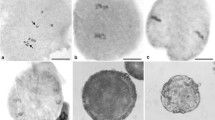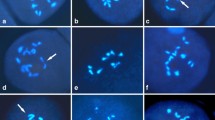Abstract
This study aimed to determine the morphological and cytogenetic differences in an intraspecific Asiatic F1Lilium hybrid. The results indicated that leaf color and shape, flower morphology including color, spot size on petal, and filament color in the F1 hybrid showed significant variations as compared to parents, while days to flowering were similar to those of the parents. Moreover, stem height, leaf number, and leaf width showed distinct variations. Interestingly, the intraspecific F1 progeny obtained from Asiatic lily parents showed higher pollen viability. In addition, FISH results revealed significant variation in the number of 18S rDNA and 5S rDNA loci identified in both parents and the F1 progeny. The female (2n = 4x = 48) parent had 12 loci of 18S rDNA, whereas the male (2n = 2x = 24) parent and the F1 (2n = 3x = 36) had 8 and 11 loci of 18S rDNA, respectively. Moreover, the F1 progeny had 9 loci of 5S rDNA compared with the 7 and 4 loci identified in the female and male parents, respectively. All 5S rDNA signals were observed on the long arm in both the female parent and the F1; however, one 5S rDNA signal was observed on the short arm in the male parent. Therefore, this study demonstrated that the distribution of ribosomal DNA was greatly different in the F1 progeny than that of parents.




Similar content being viewed by others
References
Agnieszka M, Śliwińska E, Orlikowska T (2005) Cytogenetic analysis of eight lily genotypes. Caryologia 58:359–366
Anderson NO (2006) Flower breeding and genetics: issues, challenges and opportunities for the twenty-first century. Springer, Berlin
Belandres HR, Waminal NE, Hwang YJ, Park B-S, Lee SS, Huh JH, Kim HH (2015) FISH karyotype and GISH meiotic pairing analyses of a stable intergeneric hybrid xBrassicoraphanus line BB# 5. Korean J Hortic Sci Technol 33:83–92
Bernier G, Ae Havelange, Houssa C, Petitjean A, Lejeune P (1993) Physiological signals that induce flowering. Plant Cell 5:1147
De Jong P (1974) Some notes on the evolution of lilies. N Am Lily 27:23–28
Du Y, He H, Wang Z, Li S, Wei C, Yuan X, Cui Q, Jia G (2014) Molecular phylogeny and genetic variation in the genus Lilium native to China based on the internal transcribed spacer sequences of nuclear ribosomal DNA. J Plant Res 127:249–263
Fufa H, Baenziger P, Beecher B, Dweikat I, Graybosch R, Eskridge KM (2005) Comparison of phenotypic and molecular marker-based classifications of hard red winter wheat cultivars. Euphytica 145:133–146
Fukui K (2009) Structural analyses of chromosomes and their constituent proteins. Cytogenet Genome Res 124:215–227
Harrison G, Heslop-Harrison J (1995) Centromeric repetitive DNA sequences in the genus Brassica. Theor Appl Genet 90:157–165
Hwang YJ, Kim HH, Kim JB, Lim KB (2011) Karyotype analysis of Lilium tigrinum by FISH. Hortic Environ Biotechnol 52:292–297
Jiang J, Gill BS (2006) Current status and the future of fluorescence in situ hybridization (FISH) in plant genome research. Genome 49:1057–1068
Kim JH, Kyung HY, Choi YS, Lee JK, Hiramatsu M, Okubo H (2006) Geographic distribution and habitat differentiation in diploid and triploid Lilium lancifolium of South Korea. J Fac Agric Kyushu Univ 51:239–243
Lakshmanan PS, Van Laere K, Eeckhaut T, Van Huylenbroeck J, Van Bockstaele E, Khrustaleva L (2015) Karyotype analysis and visualization of 45S rRNA genes using fluorescence in situ hybridization in aroids (Araceae). Comp Cytogenet 9:145
Lim KB, Chung JD, Van Kronenburg BC, Ramanna MS, De Jong JH, Van Tuyl JM (2000) Introgression of Lilium rubellum Baker chromosomes into L. longiflorum Thunb.: a genome painting study of the F1 hybrid, BC1 and BC2 progenies. Chromosome Res 8:119–125
Lim KB, Wennekes J, Jong JHd, Jacobsen E, Van Tuyl JM (2001) Karyotype analysis of Lilium longiflorum and Lilium rubellum by chromosome banding and fluorescence in situ hybridisation. Genome 44:911–918
Lim KB, Ramanna MS, Van Tuyl JM (2003) Homoeologous recombination in interspecific hybrids of Lilium. Korean J Breed 35:8–12
Lim K, Barba-Gonzalez R, Zhou S, Ramanna M, Van Tuyl JM (2005) Meiotic polyploidization with homoeologous recombination induced by caffeine treatment in interspecific lily hybrids. Korean J Genet 27:219
Lim KB, Yang TJ, Hwang YJ, Kim JS, Park JY, Kwon SJ, Kim J, Choi BS, Lim MH et al (2007) Characterization of the centromere and pericentromere retrotransposons in Brassica rapa and their distribution in related Brassica species. Plant J 49:173–183
Lim K-B, Barba-Gonzalez R, Zhou S, Ramanna M, Van Tuyl JM (2008) Interspecific hybridization in lily (Lilium): taxonomic and commercial aspects of using species hybrids in breeding. Floriculture 5:138–145
Marasek A, Orlikowska T (2003) Karyology of nine lily genotypes. Acta Biol Crac Ser Bot 45:2
Marasek A, Hasterok R, Wiejacha K, Orlikowska T (2004a) Determination by GISH and FISH of hybrid status in Lilium. Hereditas 140:1–7
Marasek A, Orlikowska T, Hasterok R (2004b) The use of chromosomal markers linked with nucleoli organisers for F1 hybrid verification in Lilium. Acta Hortic 651:77–82
Nadeem M, Wang X, Akond M, Awan FS, Riaz A, Younis A (2014) Hybrid identification, morphological evaluation and genetic diversity analysis of ‘Rosa × hybrida’ by SSR markers. Aust J Crop Sci 8:183
Nishikawa T, Okazaki K, Arakawa K, Nagamine T (2001) Phylogenetic analysis of section Sinomartagon in genus Lilium using sequences of the internal transcribed spacer region in nuclear ribosomal DNA. Breed Sci 51:39–46
Okazaki K (1994) Lilium species native to Japan, and breeding and production of Lilium in Japan. In: International symposium on the genus Lilium 414, pp 81–92
Okubo H (2014) History of Lilium species in Asia. In: III International symposium on the genus Lilium 1027, pp 11–26
Optiz E, Anderson N, Younis A (2009) Development of colored, non-vernalization-requiring seed propagated lilies. In: XXIII International Eucarpia symposium, section ornamentals: colourful breeding and genetics 836, pp 193–198
Pellerin RJ, Waminal NE, Kim JY, Um Y, Kim HH (2017) Fluorescence in situ Hybridization karyotype analysis of seven Platycodon grandiflorum (Jacq.) A. DC. cultivars. Korean J Hortic Sci Technol 35:784–792
Pellerin RJ, Waminal NE, Belandres HR, Kim HH (2018a) Karyotypes of three exotic cucurbit species based on triple-color FISH analysis. Korean J Hortic Sci Technol 36:417–425
Pellerin RJ, Waminal NE, Kim HH (2018b) Triple-color FISH karyotype analysis of four Korean wild Cucurbitaceae species. Korean J Hortic Sci Technol 36:98–107
Pellerin RJ, Waminal NE, Kim HH (2019) FISH mapping of rDNA and telomeric repeats in 10 Senna species. Hortic Environ Biotechnol 60:253–260
Schubert I, Fransz PF, Fuchs J, de Jong JH (2001) Chromosome painting in plants. Methods Cell Sci 23:57–69
Suzuki T, Yamagishi M (2016) Aneuploids without bulbils segregated in F1 hybrids derived from triploid Lilium lancifolium and diploid L. leichtlinii crosses. Hortic J 85:224–231
Truong NX, Kim JY, Rai R, Kim JH, Kim NS, Wakana A (2015) Karyotype analysis of Korean Lilium maximowiczii Regal populations. J Fac Agric Kyushu Univ 60:315–322
Van Tuyl JM, Arens P (2010) Lilium: breeding history of the modern cultivar assortment. In: II International symposium on the genus Lilium 900, pp 223–230
Van Tuyl J, Van Dijken A, Chi HS, Lim KB, Villemoes S, Van Kronenburg B (1998) Breakthroughs in interspecific hybridization of lily. In: XIX International symposium on improvement of ornamental plants 508, pp 83–90
Vo TC, Mun JH, Yu HJ, Hwang YJ, Chung MY, Kim CK, Kim HY, Lim KB (2015) Phenotypic analysis of parents and their reciprocal F1 hybrids in Phalaenopsis. Hortic Environ Biotechnol 56:612–617
Waminal NE, Kim HH (2015) FISH karyotype analysis of four wild Cucurbitaceae species using 5S and 45S rDNA probes and the emergence of new polyploids in Trichosanthes kirilowii Maxim. Korean J Hortic Sci Technol 33:869–876
Younis A, Ramzan F, Hwang YJ, Lim KB (2015) FISH and GISH: molecular cytogenetic tools and their applications in ornamental plants. Plant Cell Rep 34:1477–1488
Zhou S, Ramanna MS, Visser RG, van Tuyl JM (2008a) Analysis of the meiosis in the F1 hybrids of Longiflorum × Asiatic (LA) of lilies (Lilium) using genomic in situ hybridization. J Genet Genomics 35:687–695
Zhou S, Ramanna M, Visser RG, van Tuyl JM (2008b) Genome composition of triploid lily cultivars derived from sexual polyploidization of Longiflorum × Asiatic hybrids (Lilium). Euphytica 160:207–215
Zhou S, Zhong L, Zhang L, Xu Z, Liu X, Li K, Zhou G (2015) Study on the homology of the genomes of tetraploid Asiatic lilies (Lilium) using FISH. Genome 58:453–461
Acknowledgements
This study was supported by the Korea Institute of Planning and Evaluation for Technology in Food, Agriculture, and Forestry (iPET) through the Agri-Bio Industry Technology Development Program Program (or Project), funded by the Ministry of Agriculture, Food and Rural Affairs (MAFRA) (Grant Number IPET318021-4).
Author information
Authors and Affiliations
Contributions
MI and RY designed of the presented idea. JM Jung assisted to conduct the experiments and performed the computations. HY Kim, CK Kim, and KB Lim verified the analytical methods. KB Lim encouraged and supervised the findings of this work. All authors discussed the results and contributed to the final manuscript.
Corresponding author
Ethics declarations
Conflict of interest
The research being report in this publication was supported by Ministry of Agriculture, Food and Rural Affairs. I hereby disclose all of my conflicts of interest and other potentially conflicting interests, including specific financial interests and relationships and affiliations relevant to HEB.
Additional information
Communicated by Inhwa Yeam.
Publisher's Note
Springer Nature remains neutral with regard to jurisdictional claims in published maps and institutional affiliations.
Rights and permissions
About this article
Cite this article
Islam, M.M., Yesmin, R., Jung, MJ. et al. Investigation of the morphological and cytogenetic variations of an intraspecific Asiatic lily hybrid using 5S and 18S rDNA probes. Hortic. Environ. Biotechnol. 61, 339–346 (2020). https://doi.org/10.1007/s13580-019-00216-7
Received:
Revised:
Accepted:
Published:
Issue Date:
DOI: https://doi.org/10.1007/s13580-019-00216-7




